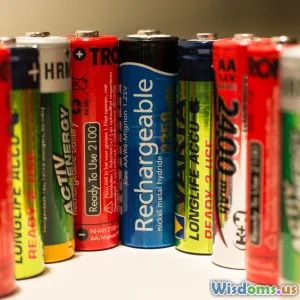
Next Generation Batteries Revolutionizing Electric Vehicles
9 min read Explore how next-generation batteries are transforming electric vehicles with improved range, safety, and sustainability. (0 Reviews)
Next Generation Batteries Revolutionizing Electric Vehicles
Electric vehicles (EVs) are no longer a futuristic ideal—they are a rapidly growing reality redefining transportation across the globe. Yet, as EVs become more mainstream, one critical factor continues to limit their widespread adoption: the battery technology they rely on. Enter next-generation batteries: innovative power sources that promise to revolutionize EVs by overcoming traditional limitations such as range anxiety, charging time, safety, and environmental impact.
This article dives deeply into the groundbreaking advancements in battery technology powering the EV boom. From solid-state batteries to lithium-sulfur and beyond, we explore how these new chemistries and designs are setting the stage for electric vehicles of the future.
The Central Role of Batteries in Electric Vehicles
In electric vehicles, the battery pack functions as the car’s heart, storing and supplying energy that powers electric motors. The performance, cost, and practicality of EVs hinge largely on battery technology. Current lithium-ion batteries, dominating the market today, have pushed electric mobility forward immensely, but exhibit several shortcomings:
- Energy Density Limitations: Typical lithium-ion batteries offer energy densities around 250-300 Wh/kg. While sufficient for many, it constrains driving ranges and vehicle weight.
- Charging Times: Despite advances, fast charging still requires 20-40 minutes for an 80% charge in many cases.
- Safety Concerns: Lithium-ion batteries can pose risks of thermal runaway and fires if damaged or improperly managed.
- Cost and Environmental Impact: They often rely on scarce metals like cobalt, raising ethical and sustainability questions.
Next-generation batteries aim to directly address these barriers.
Breakthrough Technologies Driving the Battery Revolution
1. Solid-State Batteries: The Holy Grail?
One of the most talked-about innovations is solid-state batteries (SSBs). Unlike traditional lithium-ion batteries which use liquid electrolytes, SSBs utilize solid electrolytes—often ceramics or glassy materials—that facilitate the movement of lithium ions.
Key benefits include:
- Higher Energy Density: SSBs have the potential to deliver 400-500 Wh/kg, nearly doubling current lithium-ion capacities. More energy translates into longer driving ranges.
- Enhanced Safety: The solid electrolyte is non-flammable, significantly reducing fire risks.
- Faster Charging: Solid electrolytes can enable higher charging rates without degradation.
Examples and Industry Insights:
- Toyota is aggressively developing SSB technology, aiming for commercial EV batteries around 2025.
- QuantumScape, a prominent startup, recently announced achieving 80% charge in 15 minutes.
Despite challenges in manufacturing scalability and interface stability, advancements continue at a rapid pace. Analysts predict SSBs as game-changers especially for long-range electric cars and high-performance models.
2. Lithium-Sulfur Batteries: Lightweight and Cost-Effective
Lithium-sulfur (Li-S) batteries replace the traditional lithium cobalt oxide cathode with sulfur, which is abundant and inexpensive.
Advantages include:
- Superior Theoretical Energy Density: Around 500 Wh/kg, potentially offering lighter, more energy-dense packs.
- Cost Reduction: Sulfur is plentiful and environmentally benign.
Challenges remain:
- Short cycle life due to the 'shuttle effect,' causing rapid capacity fading.
However, companies like Oxis Energy have made breakthroughs extending cycle life, making Li-S promising for future EVs, particularly where light weight is critical such as drones and urban mobility EVs.
3. Silicon Anode Batteries: Amplifying Capacity
Replacing graphite with silicon anodes can increase battery capacity since silicon can theoretically store up to 10 times more lithium ions.
Current developments:
- Tesla has indicated silicon usage in their newest cells.
- Companies like Sila Nanotechnologies are producing silicon-dominant anodes commercialized in EVs.
While silicon expands rapidly causing mechanical stress, nanostructured designs and composites are mitigating degradation, boosting safety and lifespan.
4. Sodium-Ion Batteries: Affordable and Sustainable
Sodium-ion batteries substitute lithium with sodium, which is abundant and cheaper. Though sodium ions are larger and less energy-dense than lithium, notable advances have improved their performance.
Recent breakthroughs from CATL, the world's largest battery maker, demonstrated sodium-ion batteries capable of fast charging and long cycling life, potentially supplementing lithium-ion in lower-range electric vehicles, or in regions where cost and supply chain are priorities.
5. Fast-Charging and Ultra-Fast Battery Technologies
In the race to eliminate long charging pauses, companies are exploring battery designs and chemistries capable of rapid energy uptake without sacrificing longevity.
Examples:
- Tesla’s 4680 cells: Larger form factors with tabless design enabling fast current flow.
- Graphene-enhanced batteries: Integrating graphene accelerates ion transfer.
These advances could bring superchargers down to 5-10 minutes charging times, rivaling traditional refueling convenience.
Real-World Impacts of Next Generation Batteries
Environmental Benefits
Improved energy density means fewer batteries per vehicle, reducing mining and raw materials usage. Batteries with longer cycle life alleviate waste issues. Additionally, chemistries using cobalt-free or abundant elements like sulfur and sodium avoid problematic mining, enhancing ethical sourcing.
Extending EV Range and Performance
Future EVs with solid-state or Li-S batteries could surpass 600 miles of range, rival combustion vehicles. Enhanced safety allows for better power density and integration into varied vehicle shapes and sizes.
Lowering Total Cost of Ownership
Lighter, longer-lasting battery systems contribute to reduced maintenance costs and better depreciation values. Advances in fast charging expand usability and consumer appeal.
Industry Leaders and R&D Outlook
- Toyota: Longtime proponent of solid-state cells, targeting commercial EV use around mid-2020s.
- QuantumScape and Solid Power: Leading start-ups making headlines for solid-state innovations.
- CATL: Pioneering sodium-ion as a complementary solution.
- Volkswagen and Ford: Investing billions into battery R&D with multi-chemistry approaches assuring broad applicability.
Governments worldwide funding battery innovation hubs underscore the strategic importance for energy security and climate goals.
Conclusion: Accelerating Toward an Electrified Future
Next generation batteries are poised to unlock the full promise of electric vehicles by drastically improving range, safety, environmental sustainability, and cost-efficiency. While challenges remain in mass production and commercialization, the pace of innovation offers compelling optimism.
As established automakers and startups alike push forward with these transformative technologies, EV buyers and the planet stand to gain tremendously. The coming decade is likely to witness battery-powered transportation reach new heights—driving us closer to a cleaner, greener, and more connected world.
Whether you are an EV enthusiast, industry professional, or a curious learner, understanding these battery breakthroughs highlights the pivotal role that chemistry and engineering play in shaping tomorrow’s mobility landscape.
References:
- Toyota’s Solid-State Battery Announcements (2024)
- QuantumScape Press Releases
- CATL Sodium-Ion Battery Development Updates
- Tesla Battery Day Keynote (2020)
- Oxis Energy Lithium-Sulfur Tech Whitepapers
- BloombergNEF EV Response Reports (2023)
Rate the Post
User Reviews
Other posts in Battery Technology
Popular Posts
















